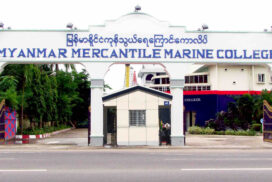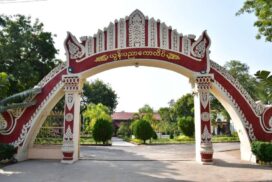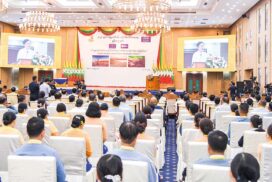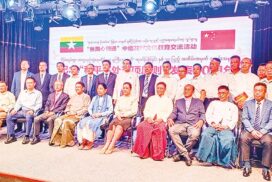By Dipa Lin
Derivation of the word “Yun” for lacquer
One has heard the word “Yun” frequently and thought about how it was derived from. The pronunciation and the word itself are appealing. It aroused his interest and curiosity. After he looked it up in the old records, he realized that it was named after Mr Yun from Manipura, Chiang Mai (Laos Shan race), who introduced the lacquer art to King Bayintnaung, according to a chronicle.
Bagan and Lacquer
Looking back to the history of Bagan, Myanmar’s saying goes that people have to argue over statements by carrying sticks as there is opposition, as usual. The information regarding Bagan and Lacquer contradicts the validity of the given statement. It is said that Bagan and lacquer art coexist in the Bagan.
Although lacquer has an attachment to ancient Bagan, lacquer was not included in Myanmar’s traditional arts and crafts, “Ten Flowers”, in the Bagan dynasty. It was believed that the lacquerware or lacquer arts had not emerged yet. On the contrary, some researchers argued that the lacquer business started in the 11th century in the Bagan dynasty. As per the notebook written by the British officer named Sin in 1795, one can see the eye-catching sight of an array of lacquerware shops in NyaungU Township.
Sin said the daily use goods such as human utensils were lacquerware. Various small objects painted lacquer, such as trays, offering bowls, cups and betel boxes to large objects like furniture and royal lacquerware, were remarkably noted. Bagan, the land of architectural wonder, is home to lacquerware.
Some chronicles of the lacquer art revealed that it could be traced back to BC 1570- 1045 BC, in which a kingdom of Shan was believed to rule in China’s Yellow River valley. The earliest known piece of lacquer is believed to have been invented by that race. During 1555-1562, King Bayintnaung conquered Manipura, Bhamo, Zinme (now Chiang Mai) and Lin Zin (currently Lan Xang). Upstream of the Shweli River (Ruili) to Yunnan province, the skilled artists were taken to Myanmar. It was when lacquerware by locals from Chiang Mai or Laos Shan was first imported, and lacquer business started thriving in the country. This way, the evolution of lacquer with a long history was implied.
U Tin, founder of lacquer art school
The lacquer art was maintained as an intangible cultural heritage in the country, and it became a profession for living. Lacquer art has flourished since its introduction to Myanmar. U Tin, a retired assistant officer to a Bagan (Wundauk) in the Colonial era, was devoted to traditional arts. He tried establishing a lacquer art vocational school in Bagan to preserve the cultural heritage. He opened a self-help school after a fruitful discussion with the local artists, and then the state-owned college was opened in 1924.
Lacquerware Technology College producing artists in Bagan
The school was opened in 1924. The school was upgraded to an institute in 1995 and then to a college on 29 December 2003. The government changed the course duration of the lacquer art vocational school from three years to one year in March 1960. The school offered a one-year course every year from March 1960 to March 1965.
The college offers the following courses. Those enthusiastic with graduate (under 35 years) and post-graduate (under 25 years) education can join one-year and two-year diploma courses, respectively. Those who successfully accomplished the two-year diploma course starting from 2011 intake are entitled to attend the University of Cooperatives and Management (Sagaing and Thanlyin) and can receive a bachelor’s degree.
There are Economics, Commerce, Statistics, Management Studies, Cooperative Studies, ICT, Myanmar, English, Mathematics, Law, and Economic Geography faculties. The subjects related to lacquer include lacquer arts, base crafting, lacquer painting, Shwe Za Wah Yun, Kanyit Yun, lacquer floral and pattern, Panchi (traditional art of painting), Panpu (traditional sculpture) and international lacquer arts.
Cooperation with international institutions
Lacquerware Technology College-LTC (Bagan) had several affiliations and was made partner with Japan for lacquer craft exchange programmes in 1953. Between 2004 and 2017, in collaboration with the Asian Lacquer Craft Exchange Research Project of Japan, international lacquerware expos and technology exchanges were conducted. The LTC signed a Memorandum of Understanding 2013-2015 with Japan’s Tokyo National Research Institute for Cultural Properties (TNRICP) for research activities of ancient lacquerware from the Lacquer Museum. In 2015, the LTC cooperated with the United Nations Industrial Development Organization and Ms Doniela Bulgarelli, an expert from Italy, conducted a Lacquer Product design and development course for the staff of the college and lacquer businesspersons from Bagan.
Moreover, the LTC and Italy’s Accademia of Fine Arts (Turin) inked an agreement for handicraft exchange and research activities. From 2 to 4 September 2017, the LTC worked with Japan’s Tokyo National Research Institute for Cultural Properties for lacquer cultural exchanges, the Principal of the LTC (Bagan) elaborated.
Alumni on track for employment
The college produced 2,549 alumni between 1924-1925 and 2023-2024 academic years. Of them, 15 can set up their own businesses, 80 serve as civil staff, and 550 join private firms. Thirty among them are engaged in the lacquerware industry for a living. The college helped 675 people hunt for jobs.
LTC offers vocational intensive courses
The LTC offered vocational intensive courses to effectuate sustainable development in the lacquer industry, foster community development in Bagan, and create greater job opportunities. The courses comprise Shwe Za Wah Yun technology, black lacquer painting art, Kanyit Yun technology, floral and pattern design, wooden-based crafting, Japan lacquer technology and manufacturing of lacquer human utensils. The college opened its 26th batch between 2015-2016 and 2023-2024 Academic Years, with 445 trainees.
The principal affirmingly addressed that the goals and objectives behind the LTC are preserving lacquer arts and technologies, protecting them from extinction and passing them on to generations for sustainable development.
In collaboration with lacquer artists from affiliated colleges to meet international standards, the LTC recently marked its 100th anniversary, intending to become the central hub and heart of Myanmar’s lacquer industry. This article is written to honour the remarkable history of the LTC.
— Translated by EMM















